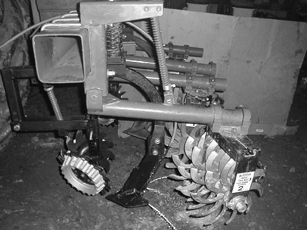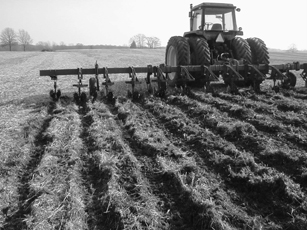A persistent desire for a better strip-till rig led Advance, Mo., no-tiller Paul Lanpher to develop his Dream Machine about 9 years ago.
Lanpher grows mostly wheat, soybeans and corn. He double-crops wheat with soybeans, following with corn the next year. It’s a rotation that’s worked well for his 50-plus years of farming.
Lanpher changed over to no-till about 15 years ago. While he was happy with his results, he noticed that the continual traffic on his fields, due in part to his wheat-soybean-corn rotation, was starting to cause compaction problems.
“In my double-crop system, there’s a lot of wheel traffic from spraying, planting and combining,” he says. “That’s when I started looking at some strip-till options.”
He thought the equipment on the market that he researched didn’t exactly meet his needs, so Lanpher set out to design his own strip-till rig that would do exactly what he wanted it to do.
Lanpher’s Dream Machine spreads nitrogen with a Conservation Jet (C-Jet) in a wide band under the seedbed. The knife and sweep loosen a strip of soil about 10 inches wide and 6 to 8 inches deep. Two rolling cultivator gangs run on the ridge of soil behind the C-Jet, chopping and settling the seedbed. If needed, the rolling cultivator gangs can be adjusted to pull residue back in closer to the row.
Lanpher has modified his original design to now include C-Jet units with a 6-inch, 8-inch or 10-inch sweep that is easy to replace. “Depending on the conditions, you can modify the width of the sweeps,” Lanpher says. And brackets and shanks are economical, so they can be mounted to work on most tool bars, he says.
“I studied what could be used to make the seedbed better behind the C-Jet,” Lanpher says. “And I found that the rolling cultivators do a better job than anything out there. They chop up the soil and residue and pull a little soil back in the knife slot. It creates a perfect seedbed that rivals anything conventional tillage can do.”
The nitrogen is spread out enough that it doesn’t hurt the seed, he says, while getting the young plants off to a good start. On his irrigated ground, Lanpher puts down 180 pounds of anhydrous ammonia with his strip-till rig, then usually spreads about 40 pounds of nitrogen on top of the soil and pushes another 50 pounds of nitrogen through his center-pivot irrigation. “With only 1 percent to 1 1/2 percent organic matter, I don’t have a lot of nitrogen in the soil,” he says.
Soil tests are conducted every other year to ensure Lanpher’s fertility program is on par with the needs of his soils. His program pushes his corn yields to about 225 bushels to the acre.
Two years ago, he tried a 16-row, pull-type planter, but it was difficult to keep the row units on the strips. “The wheels of the planter kept drifting over the strips, making it difficult to plant in the strips,” Lanpher says. “The planter wheels were running in the loose seedbed strips.”
He tried mounting some heavy-duty guide coulters on the planter to help keep the wheels between the rows, but found that a mounted, or semi-mounted, planter works best with his Dream Machine.
“On flat land where erosion is not a problem, I use a 16-row Dream Machine with five spider gangs to build ridges for a seedbed and inject anhydrous and plant corn the same day,” Lanpher says.
Manage Residue
Lanpher says his most difficult task at planting is managing the residue on his soils, especially after a year of wheat and soybeans. “The wheat straw and soybean stubble is a bit too much,” he says.
That’s why he uses a row cleaner when the residue is thick. “In a normal year, a coulter can cut through the residue easy enough,” he says. “But with wheat straw and soybean stubble, the row cleaner works much better.”
Lanpher also has designed what he calls his Stripper-Scratcher, a 16-row unit that helps remove residue from the seedbed strip 2 to 3 days prior to planting.
“It’s basically a toolbar with row cleaners to get residue out of the way,” he says. “It helps to dry and warm the soil for a better seedbed and lets me plant my strip-till corn earlier.”
Not Standing Still
With 7 planting seasons under his belt with his Dream Machine, Lanpher continues to fine-tune his design to provide optimum results. For 2007, he has partnered with Bingham Brothers to manufacture his Dream Machine, and he’s added several improvements to his patented unit.
“The knife has a stainless steel tube for spreading liquid nitrogen or anhydrous,” he says. The knife and quick-attach sweeps are manufactured and sold by Nichols Tillage Tools.
 He also has several options for his unit, including rigid or double-spring-loaded shanks, row cleaners or coulters, three, four or five-spider rolling cultivator gangs, and a rolling seedbed conditioner. “Each unit can be mounted to almost any sized tool bar,” Lanpher says.
He also has several options for his unit, including rigid or double-spring-loaded shanks, row cleaners or coulters, three, four or five-spider rolling cultivator gangs, and a rolling seedbed conditioner. “Each unit can be mounted to almost any sized tool bar,” Lanpher says.
Lanpher is sold on his unit and believes that it prepares an excellent seedbed for his rolling, loam soils.
“The unit makes a good seedbed while spreading nitrogen and the planter stays on the strip,” he says. “And with high-priced seed corn, you want the best seedbed possible to get the most out of your crop.”

With 225-bushel-plus corn yields, Lanpher is satisfied that his unit does the job. In 2005 he saw a plot yield of 277.9 bushels per acre, which was good enough for second place in Missouri’s National Corn Growers Association yield contest.
Lanpher doesn’t consider himself an inventor, just a farmer who is looking to make something that helps him increase his yields. While he does have a manufacturer for his Dream Machine, Lanpher is just starting to see some of his units find a home on other farms. “It’s a piece of equipment that’s not for everyone, but it definitely has its place for some producers,” he says.
And Lanpher believes that his original goal of eliminating his compaction problems has been fulfilled. “I have a better seedbed and better yields,” he says. “I’m seeing an 8- bushel to 10-bushel per acre increase in yields over no-till.”
Home-Grown Solution

Paul Lanpher designed this strip-till unit to meet his needs. The Conservation Jet (above) spreads nitrogen in a wide band under the seedbed, while the wings on the C-Jet lift and loosen a strip of soil. The rolling cultivator gangs run on the ridge of soil behind the C-Jet and pull soil back in and fill the slot made by the C-Jet shank (below). They also chop and settle the seedbed and can be adjusted to pull more residue back closer to the row.
Clearing The Way
The 16-row Stripper-Scratcher (below) removes residue from the row 2 to 3 days before planting, allowing the soil to dry and warm up for a better seedbed and earlier planting of no-till or strip-till corn. Adjustments are available for removing more or less soil from the seedbed, as needed.
(Editor's Note: This article originally appeared in the May 2007 issue of No-Till Farmer.)





